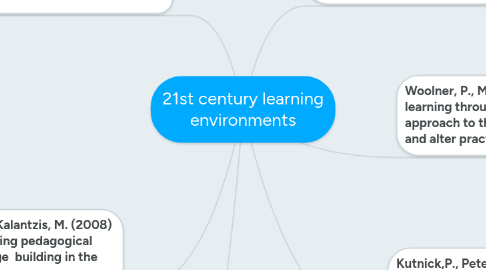21st century learning environments
作者:David Jay

1. Yelland, N., Cope, B. and Kalantzis, M. (2008) Learning by design: creating pedagogical frameworks for knowledge building in the twenty-first century
1.1. More open classrooms?
2. Factor, J. (2004) Tree stumps, manhole covers and rubbish tins: the invisible play-lines of a primary school playground
2.1. Giving children a voice when it comes to modifying their playgrounds. And the education of parents and teachers of the importance of play on a child's development.
2.2. The playground is an area where students freely express themselves as Factor articulated the comparison that play functions for children as arts does for adults, therefore it is vital that children not to be excluded from having a voice in the design space of their playgrounds as the playground belongs to them. - Suz
3. Saltmarsh, S., Chapman, A. Campbell, M. and Drew, C. (2014) Putting “structure within the space”: spatially un/responsive pedagogic practices in open-plan learning environments.
3.1. The learning needs are different because of changes of technology and how students learn
3.2. In open classrooms, students are self-directing their learning. They also imply team-teaching, which means teachers share resources and responsibilities (Stephanie)
4. Woolner, P., McCarter, S., Wall, K. and Higgins, S. (2012) Changed learning through changed space: when can a participator approach to the learning environment challenge preconceptions and alter practice?
5. Kutnick,P., Peter Blatchford, P. and Baines. E. (2002) Pupil Groupings in Primary School Classrooms: Sites for learning and social pedagogy?
6. Youdell, D. and Armstrong, F. (2011) A politics beyond subjects: the affective choreographies and smooth spaces of schooling
6.1. This reading touches on a subject that I am quite opinionated about, that being the choreographies and the set up of the classroom. My prac class is also a weird set up, almost with two rooms joint together, one where my class is and the other appearing like an extension that anyone can use. This causes several interruptions to my class and forces my teacher to constantly apologise to her students for the noise of the other class. In saying this, the students don't seem to bothered by it, but it does seem to be placing additional strain on my teacher. What I agree with about this article is the idea of creating a classroom based on the individuals within the class and not just a 'one size fits all' classroom. One year there may be a class that works extremely well when they are working in groups and learning from each other, but the following year this may cause chaos and conflict. The teacher needs to adjust the classroom and the learning styles to suit the students to optimise learning - whether this is an open plan style classroom or a more simplistic set up should be based on the students. - Amy


